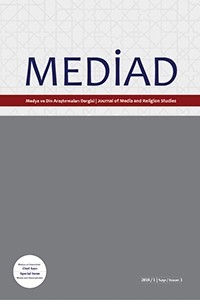Dijital Çağda Din ve Dindarlığın Dönüşümü
Günümüz iletişim teknolojilerinin toplumsal yaşama egemen olduğu çağ, dijital çağ olarak tanımlanmaktadır. Bilgisayar, akıllı telefon, tablet, internet ve benzeri dijital iletişim teknolojilerinin kullanımı ve gittikçe artan işlevleri toplumsal hayatın; iktisadi, kültürel ve dini boyutlarını da içerisine alan bir dijitalleşme sürecini beraberinde getirmiştir. Bu durum, toplumsal düzlemde yeni bir sosyal sistem inşa etmiş, geleneksel toplumsal yapı ile kurumlarda yaşanan değişim ve dönüşümü hızlandırmıştır. Bu süreçte önemli bir toplumsal kurum olan dinin ve dindarlık anlayışlarının içerik ve şekil açısından bir değişime uğradığı gözlemlenmektedir. Bu bağlamda dijital çağdaki birey/toplum ile din arasında kendine özgü bir ilişki ortaya çıkmış; dini anlayış, pratik ve örgütlenme biçimleri yeni bir form kazanmaya başlamıştır. Dijitalleşme sürecinin en önemli ayağı olan yeni medya ve mobil iletişim teknolojileri ise, dinin; inanç, ahlak, ibadet, cemaat ve benzeri unsurları üzerindeki yerleşik dini kabul ve dindarlık anlayışlarının değişimine yol açmıştır. Dijitalleşme sürecini bu bağlamda ele alan çalışma, toplum hayatına eklemlenen dijital iletişim teknolojilerinin özellikle de dijital medyanın toplumdaki dini anlayış ve dindarlığı nasıl dönüştürdüğünü nitel yaklaşımla analiz etmeyi amaçlamaktadır.
Anahtar Kelimeler:
Dijitalleşme, İnternet, Din, Dindarlık
The Transformation 0f Religion and Piety in Digital Age
Today can be described as a digital age in which communication technologies prevail the social life. Use of computers, smart phones, tablets, internet and similar communication technologies and the increasing function of these brings along a digitalization process which embraces the economic, cultural and religious dimensions of social life. This has constructed a new social system on the societal level, bringing change and transformation in the social structure and institutions. Within this period, religion, being an important social institution and religiosity are observed to change substantially in terms of form and content. In this sense, a sui generis relation between religion and individual/society of the digital era, patterns of religiosity, practice and organization have started to turn into a new form. Internet and mobile communication technology, one of the most important agents of the digitalization era, has led the intrinsic acceptances of religious elements such as faith, worship, and community to change. This study, which approaches digitalization process in this context, aims to carry out a qualitative analysis on how digital technology, especially digital media that has become a constituent of social life, has transformed the perception of religion and piety in the society.
___
- Arvidsson, A. ve Delfanti, A. (2019). Introduction to digital media. New Jersey: John Wiley&Sons Inc.
- Baudrillard, J. (2005). Simülakrlar ve simülasyon. (çev. Oğuz Adanır), Ankara: Doğubatı Yayınları.
- Bellar, W. R., Cho, K. J. ve dğr. (2018). The intersection of religion and Mobile technology. İçinde Mehdi Khosrow-Pour (Ed.), Encyclopedia of Information Science & Technology, PA: IGI Global, 6161-6170.
- Campbell, A. H. (2013). Introduction: The rise of the study of digital religion. İçinde Heidi A. Campbell (Ed.), Digital Religion: Understanding Religious Practice in New Media, London: Rautledge, 1-22.
- Campbell, A. H. ve dğr. (2014). There’s a religious app for that! A framework for studying religious mobile applications. Mobile Media & Communication, 2(2), 154–172.
- Carey, J. W. (1992). Communication as culture: Essays on media and society. New York: Routledge.
- Castells, M. (2006). Enformasyon çağı: Ekonomi, toplum ve kültür. Birinci Cilt: Ağ Toplumunun Yükselişi, (Çev. Ebru Kılıç), İstanbul: İstanbul Bilgi Üniversitesi Yayınları.
- Dereli, M. D. (2019). Dinî kimliklerin siber uzamda akışkanlaşması. İnsan &Toplum, 9(1), 85-115.
- Grimes, R. (2002). Ritual and the media. Practicing Religion in the Age of The Media: Explorations in Media, Religion and Culture, İçinde Stewart Hoover and Lynn Schofield Clark (Ed.), New York: Columbia University Press, 219-234.
- Grieve, G. P. (2013). Digital religion, İçinde Heidi Campbell (Ed.), Digital Religion: Understanding Religious Practice in New Media Worlds. New York: Routledge, 104-118.
- Haberli, M. (2014). Sanal din: Tarihsel, kuramsal ve pratik boyutlarıyla internet ve din. İstanbul: Açılımkitap.
- Helland, C. (2000). Online-Religion/Religion-Online and virtual communitas. İçinde Hadden, J.K.-D.E. Cowan (Ed.), Religion on the Internet: Research Prospects and Promises, London: JAI Press/Elsevier Science, 205-233.
- Hoover, S. ve Echchaibi, N. (2014). Media theory and the third Spaces of digital religion. The Center for Media, Religion, and Culture, Boulder, CO: University of Colorado, 1-35.
- Hutchings, T. (2015). E-Reading and the Christian Bible. Studies in Religion/Sciences Religieuses, 44(4), 423-440.
- Kafalı, H. (2019). Yapay zekâ, toplum ve dinin geleceği. Ondokuz Mayıs Üniversitesi İlahiyat Fakültesi Dergisi, sayı: 46, 145-172.
- Mcluhan, M. (2001). The medium is the message: An inventory of effects. California: Gingko Press.
- https://thirdspacesblog.files.wordpress.com/2014/05/third-spaces-and-mediatheoryessay-2-0.pdf Erişim: 12 Şubat 2019.
- ISSN: 2636-8811
- Başlangıç: 2018
- Yayıncı: Erciyes Üniversitesi
Sayıdaki Diğer Makaleler
Batı’nın Bir Ötekisi Olarak İslam ve Müslümanlar: Batı Avrupa Medyasında İslamofobinin Temsili
Yeşilçam Dönemindeki Hazretli Filmlerde Yer Alan Hataların Değerlendirilmesi
Evanjelik Hareket ve Radyo Televizyon Yayıncılığı
Dijital Çağda Din ve Dindarlığın Dönüşümü
Hashtag Islam: How Cyber-Islamic Environments are Transforming Religious Authority
Türk Halk Dindarlığının Diyanet Medyasına Yansımaları
